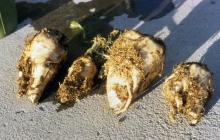Cause Meloidogyne hapla is a sedentary endoparasite; only second-stage juveniles (the infective stage) and adult males (which may be rare) are in soil.
Symptoms Beets are stunted in small, conspicuous areas of the field. Infected beets are much smaller than healthy ones. In severely infested fields, areas of decline usually can be identified by excessive leaf wilting in hot weather. Carefully remove those beets and examine them for swellings or knots. If infected early, the tap root has numerous knots. Later infections occur principally on secondary roots. Later in the season, these areas often are marked by the absence of beets and presence of weed patches.
Sampling Before planting, take soil samples with sufficient lead time to implement management procedures if necessary. For example, it may be several weeks after fumigation before crops can be planted. Fall sampling for crops to be planted the following spring is an excellent strategy. When sending samples for diagnosis, include beets and roots as well as soil.
Cultural control
- Plant in nematode-free soil.
Chemical control
- Fumigate soil before planting. Telone II at 9 to 12 gal/A broadcast on mineral soils. Restricted-use pesticide. Wait 2 to 3 weeks after applying before planting, or until odor leaves the soil. Do not treat extremely heavy soils. 5-day reentry.
Biological control
- MeloCon WG at 6 to 9 lb/A as an in-furrow application at planting for nematode suppression. 4-hr reentry. O


